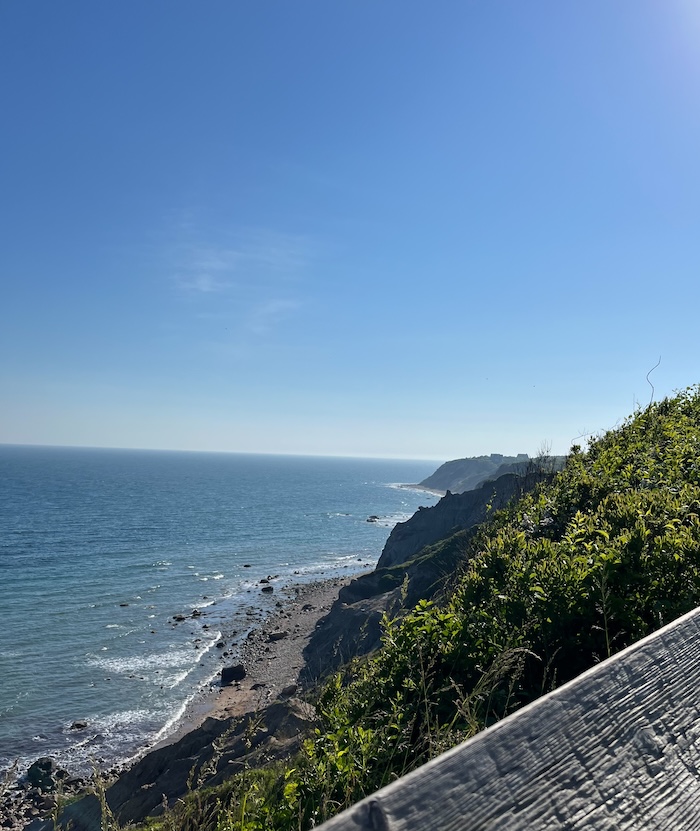Block Island is well preserved — lots of open space, scenic farms, etc.

Here’s a 9-mile loop on the southern half of Block Island; I walked the loop counter-clockwise, heading west to begin the walk.
Much of the above route is on paved roads. The roads are quite pleasant, though somewhat narrow for walking or biking; I saw no bikepaths on Block Island. Many of the houses in the interior seemed to be 50-75 years old, and rather modest. Along the shore, there are newer, larger houses. As I walked in the interior, I was reminded of Shelter Island (in eastern Long Island).
The terrain is “up hill and down dale” — there are few flat areas on Block Island. Perhaps the whole island is a morraine, where the glacier stopped advancing, lingered, dropped material, and created hollows. Perhaps the island’s most conspicuous feature are the giant bluffs on the south shore. These bluffs have probably been shrinking since they were created by the glacier, but are huge nonetheless. I was reminded of Ireland’s Cliffs of Moher.
While the Cliffs of Moher are stone, Block Island’s bluffs are clay/sand/gravel, hence Block Island’s bluffs are eroding. When I was on Block Island in June 2024, it was difficult to reach the beach because of erosion; access is blocked by fences, staircases have been damaged by the ocean.
My route follows a route in Ken Weber’s Walks and Rambles in Rhode Island. For additional details, and an alternate route, see Ken’s More Walks and Rambles in Rhode Island. You may want to consult a more recent book; Ken’s books are becoming dated.
I put 3 pins on the above map, in the southeast, marking my futile efforts to reach the beach. The blue pin is where Ken recommends going to the beach; this access point is now blocked by a fence, to reduce erosion, and to reduce the risk of falling. The red pin is the “classic” access point, with a sign, a parking lot, and a big staircase to the beach. Recently, however, the staircase was damaged by the ocean. The green pin is the Southeast Lighthouse — a scenic spot, but it doesn’t afford access to the beach.
Is there any way to get to the south beach, and see the giant bluffs from below? Next time I’ll try descending to Black Rock Beach, in the southwest corner of my loop. I missed this spot because I left Ken’s route at my yellow pin; I turned left instead of continuing straight on Black Rock Road. I wanted to get a better view of Rodman Hollow, which Ken calls “one of the island’s natural highlights.” My route is slightly east of Ken’s route, and slightly shorter than Ken’s route. Rodman Hollow isn’t really one hollow, it’s “a series of hollows and hills” (as Ken says in More Walks).
When the Southeast Lighthouse was being built in the 1870s, local farmers warned the builders, “There’s continual erosion, we need to move our fences back every ten years.” The lighthouse itself had to be moved back in 1993. Wikipedia says, “Because of ongoing erosion of the bluffs, in 1993 the entire 2,000 ton structure was moved about 300 feet (91 m) back from the cliffs.” Sankaty Lighthouse in Nantucket was also moved back.
The southeast bluffs are called “Mohegan Bluffs” because in 1590, a raiding party of 40 Mohegan warriors were driven off the bluffs by the local Indians, the Manisses or Niantic. They say you can see Montauk Point (eastern Long Island) from the top of Mohegan Bluffs. You can also see a line of giant windmills in the ocean. I saw a pair of bald eagles, with white heads and white tails, flying lazily along the south shore, while crows harassed them.

Mohegan Bluffs
I had good cell reception, so I could use AllTrails. Google Maps might also be useful. There’s lots of grass, so ticks could be a problem. The paved roads are open and sunny, so you may want a hat and suncream. On the other hand, the greenway trails are shady.
The greenway is now quite long, you can walk from Great Salt Pond in the north to Black Rock Beach in the south; such a walk might be preferable to Ken’s route. On the map below, I marked (in red) one possible route along the greenway; this route would be 5-6 miles.
